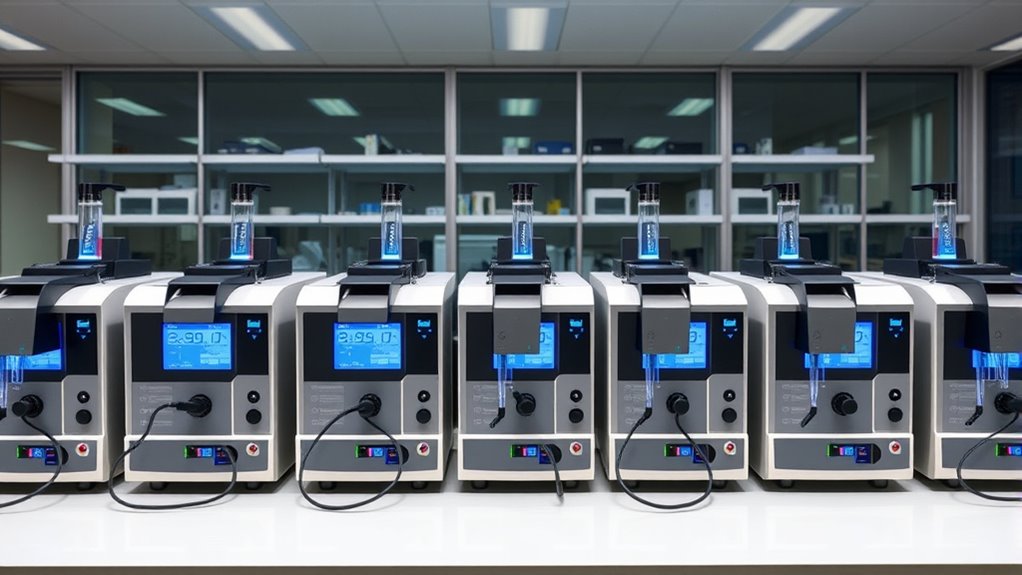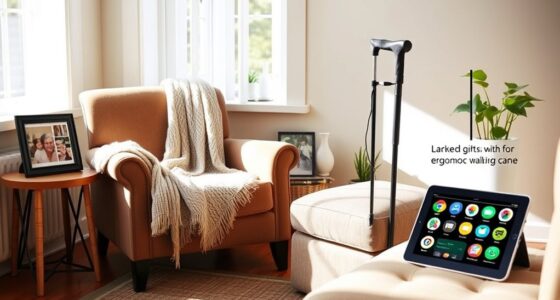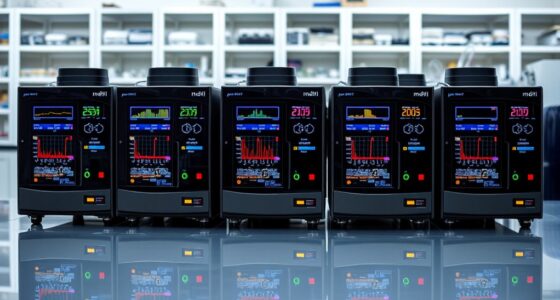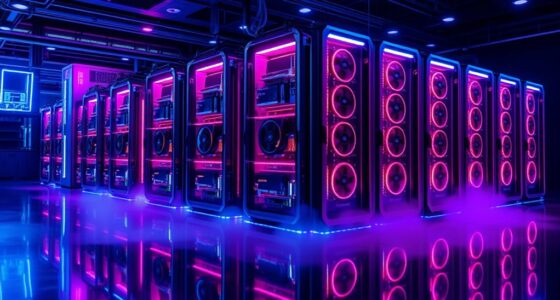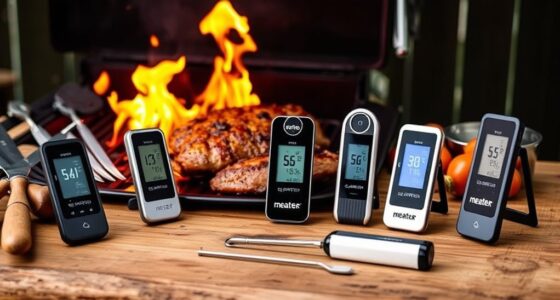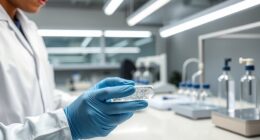If you’re seeking the best atomic absorption spectrophotometers for precise, reliable analysis, I recommend exploring options that feature broad spectral ranges, high-precision sensors, and user-friendly interfaces. Portable units are ideal for field work, while larger benchtop models excel in stability and accuracy. Safety, maintenance support, and data management are also key factors. Keep in mind that the right device depends on your specific needs, and there’s more to discover as you continue exploring these top choices.
Key Takeaways
- Range of models offering high accuracy, stability, and advanced features tailored for precise atomic absorption analysis.
- Portable and benchtop options with user-friendly interfaces, supporting diverse measurement standards.
- Features like auto-calibration, spectral data collection, and extensive data storage ensure reliable results.
- Safety and maintenance features, including automatic gas cut-off and support services, enhance device longevity.
- Selection depends on application needs, balancing portability, spectral coverage, measurement speed, and precision.
AAS 5800 Atomic Absorption Spectrophotometer for Metal and Environmental Testing
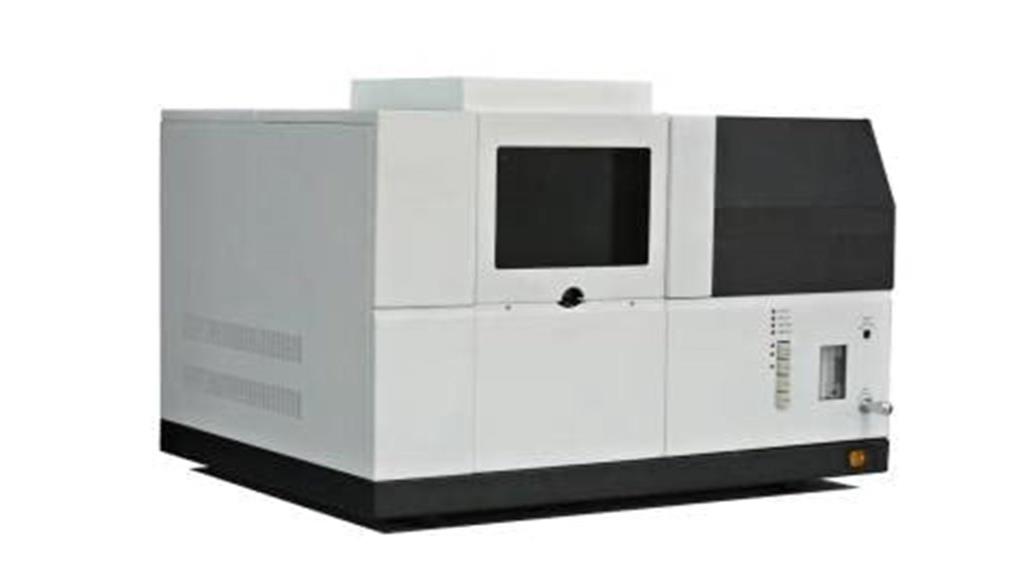
If you’re looking for a reliable and versatile atomic absorption spectrophotometer for metal and environmental testing, the AAS 5800 is an excellent choice. I find its wide wavelength range of 190-900nm perfect for analyzing various metal elements, from heavy metals in water and soil to ores and food samples. Its high-precision measurements, with baseline drift ≤ 0.004abs/30min, ensure accurate and consistent results. Plus, the user-friendly design, including an automatic ignition and simplified operation panel, makes it easy to operate quickly. Safety features like gas cut-off and low-pressure protection give me peace of mind during testing.
Best For: professionals and laboratories conducting precise metal and environmental testing across water, soil, food, air, and ore samples.
Pros:
- Wide wavelength range (190-900nm) suitable for analyzing diverse metal elements.
- High-precision measurements with baseline drift ≤ 0.004abs/30min ensure reliable results.
- User-friendly design with automatic ignition and simplified operation panel for quick setup.
Cons:
- May require technical training for optimal operation despite its user-friendly features.
- Potentially higher initial investment compared to basic spectrophotometers.
- Limited information on maintenance requirements or long-term durability.
GOYOJO Portable Spectrophotometer 721
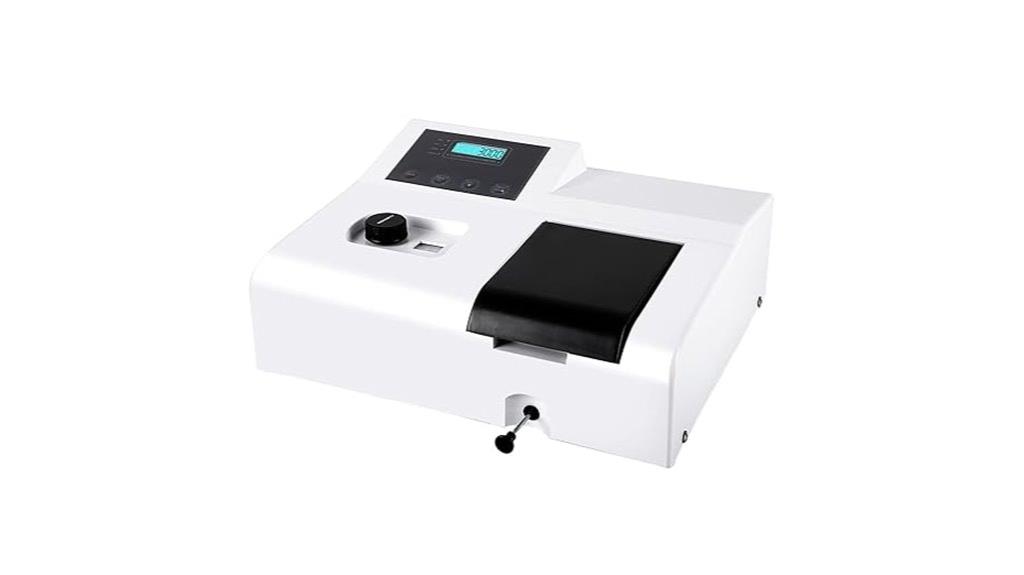
The GOYOJO Portable Spectrophotometer 721 stands out as an excellent choice for professionals who need reliable, high-precision spectral measurements in the field or laboratory settings. It features a 6nm Tungsten Lamp and operates at 110V, making it versatile for various environments. With a photometric accuracy of ±1%T and repeatability of 0.5%T, I trust its consistent results. Its stability of ±0.004A/h at 500nm ensures dependable long-term data collection. The device’s user-friendly design, clear digital display, and straightforward operation make it accessible to users of all experience levels. Compact and durable, it’s ideal for research, quality control, and diagnostics.
Best For: professionals and researchers requiring precise, reliable spectral measurements in laboratory or field environments across industries like food, pharmaceuticals, and water analysis.
Pros:
- High photometric accuracy of ±1%T ensures reliable results
- Stable performance with ±0.004A/h stability at 500nm for long-term experiments
- User-friendly design with clear digital display and straightforward operation
Cons:
- Operates only at 110V, which may require adapters in some regions
- Limited to spectral measurements within the 350-1020nm range, not suitable for UV-only applications
- Compact design may limit additional advanced features found in larger spectrophotometers
45°/0 Spectrophotometer with Capacitive Touch Screen and Integrating Sphere
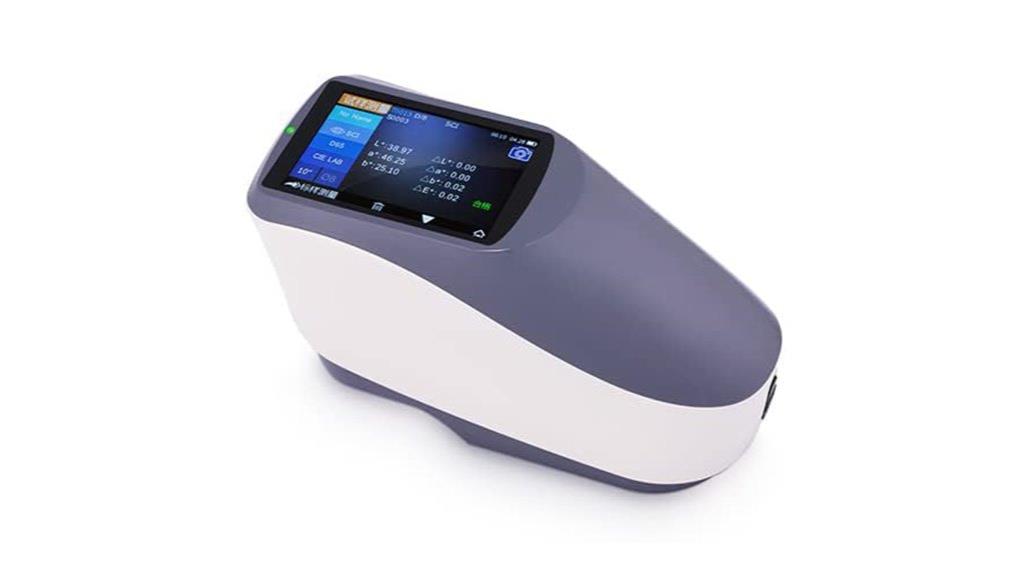
A spectrophotometer with a capacitive touch screen and integrating sphere is an excellent choice for professionals demanding precise color measurements. Its 45°/0 configuration ensures accurate reflectance readings, while the 48mm sphere size accommodates various sample types. The device offers customizable apertures, including Φ8mm, Φ10mm, Φ4mm, Φ5mm, Φ2mm, and Φ3mm, providing flexibility for different measurement needs. With a large data storage capacity of 500 samples and up to 20,000 data points, it supports extensive analysis. Advanced features like multiple illuminants and standard observer angles make it versatile across industries, guaranteeing consistent, reliable color accuracy.
Best For: professionals and industries requiring highly accurate and versatile color measurement solutions, such as textiles, paints, plastics, and quality control laboratories.
Pros:
- High precision with inter-instrument error within ΔE*ab 0.2, ensuring consistent color measurement across devices
- Multiple customizable measuring apertures and diverse illuminants for flexible testing options
- Large data storage capacity supporting extensive sample analysis and detailed data management
Cons:
- Possibly higher cost due to advanced features and hardware specifications
- Larger device size may require dedicated space in the workspace
- Learning curve for users unfamiliar with advanced spectrophotometry equipment
High Performance F97Pro Spectrophotometer
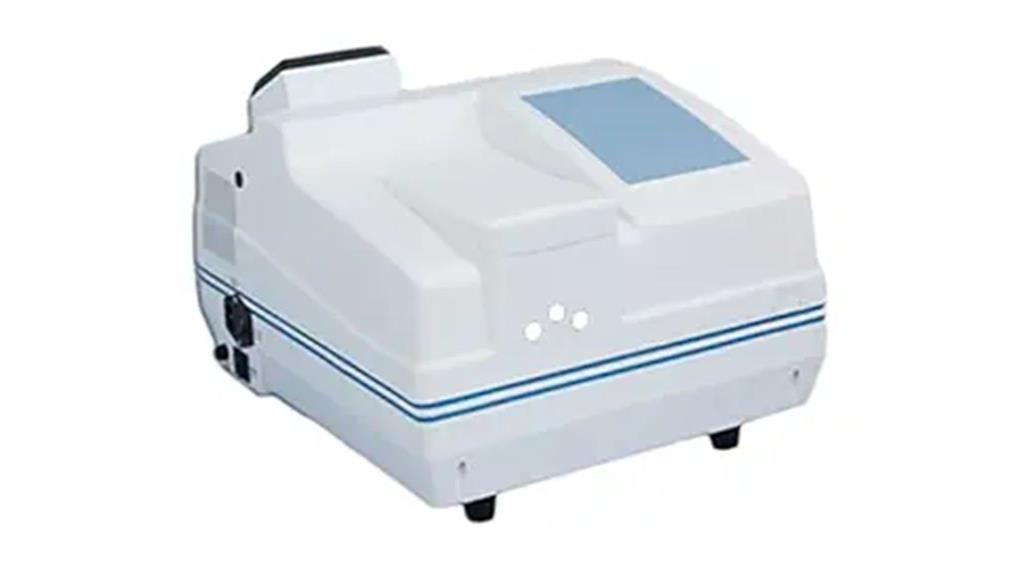
Designed for high-precision fluorescence analysis, the High Performance F97Pro Spectrophotometer offers an impressive wavelength range of 200-900nm, making it ideal for researchers who demand both sensitivity and speed. It features advanced optical design and weak signal detection technology, achieving a signal-to-noise ratio over 200, surpassing many competitors. With Hamamatsu’s high-quality Xenon light source and photoelectric multiplier detectors, it ensures strong light intensity and high detection sensitivity. Its high-speed digital processing allows scanning at 48,000 nm/min, generating spectra in seconds. The dual monochromator design broadens spectral coverage, while the stability system maintains measurement accuracy, making it a reliable choice for fluorescence analysis.
Best For: researchers and laboratories requiring high-speed, high-sensitivity fluorescence measurements across a broad spectral range from 200 to 900 nm.
Pros:
- Exceptional signal-to-noise ratio exceeding 200 for reliable detection of weak signals.
- Fast scanning speed of up to 48,000 nm/min allows rapid data acquisition.
- Wide spectral coverage with dual monochromator design for versatile fluorescence analysis.
Cons:
- May have a higher purchase cost due to advanced features and high sensitivity.
- Requires proper training to maximize the instrument’s complex optical and electronic capabilities.
- Larger size and power consumption might limit portability for some users.
Spectrophotometer Φ11mm Handheld Spectrophotometer with High Accuracy
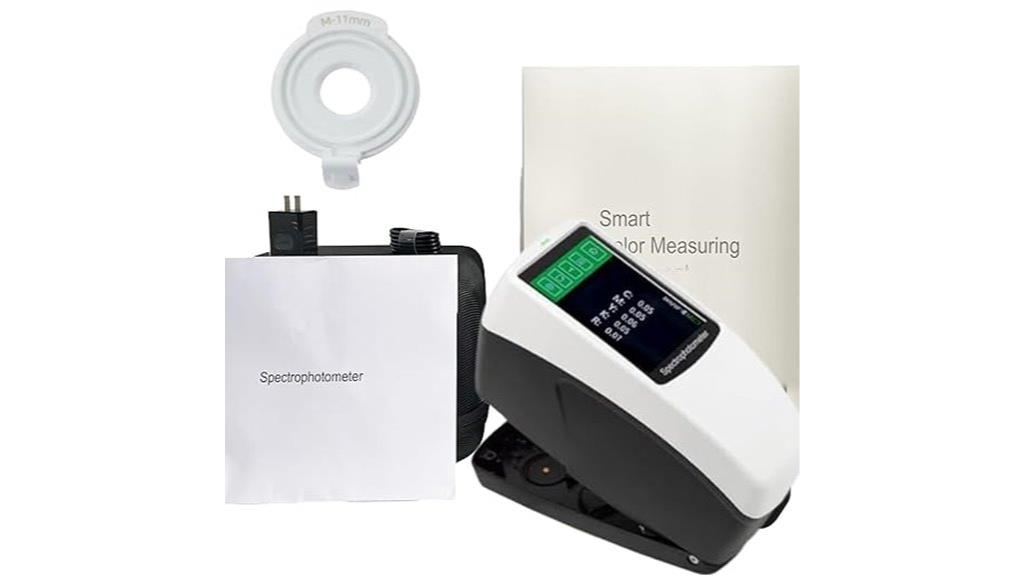
If you need precise color measurement in a handheld device, the Spectrophotometer Φ11mm Handheld Spectrophotometer with High Accuracy stands out. Its low center of gravity design guarantees stability during testing, while the physical observation window helps reduce errors by allowing real-time measurement positioning. With an interchangeable Φ11mm aperture, it offers versatility across various applications. The device delivers ultra-high accuracy with a dE*ab ≤ 0.02, and measurement is lightning-fast at about one second. Supporting over 30 color indicators and nearly 40 evaluation light sources, it’s perfect for industries demanding reliable, consistent color analysis in a portable format.
Best For: professionals in industries like textiles, coatings, plastics, and printing requiring high-precision, portable color measurement solutions.
Pros:
- Ultra-high measurement accuracy with dE*ab ≤ 0.02 ensures reliable color consistency.
- Rapid measurement time of approximately 1 second increases efficiency.
- Supports extensive measurement parameters and evaluation light sources for versatile applications.
Cons:
- Handheld design may be less suitable for large-scale or batch testing compared to fixed instruments.
- Requires familiarity with software modules for optimal data management and analysis.
- Higher initial investment cost may be a consideration for some users.
Spectrophotometer with Aperture Ø8mm and 10000 Sample Storage
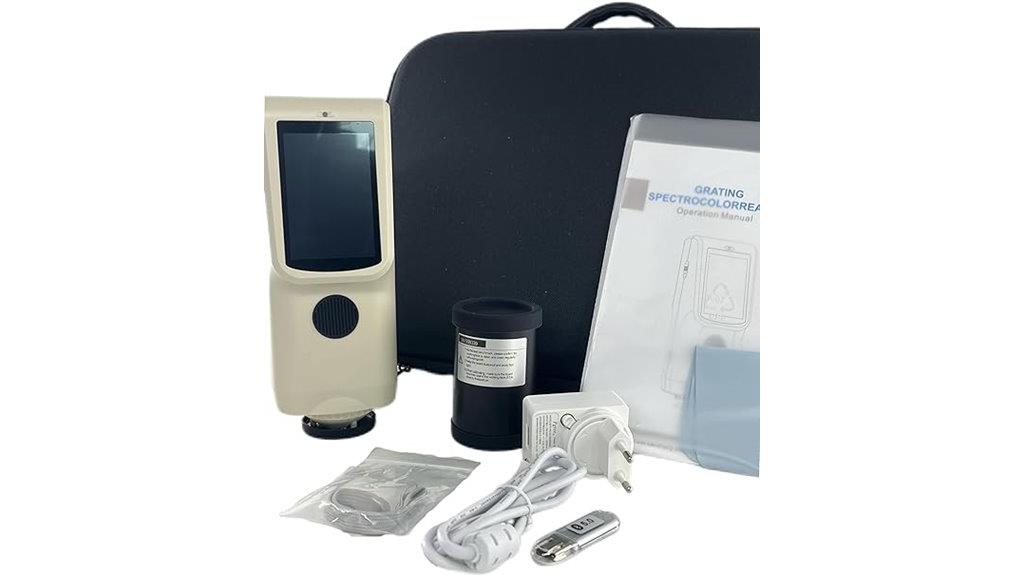
For professionals who need rapid, accurate color measurement with large data management, the spectrophotometer featuring an Ø8mm aperture and 10,000 sample storage stands out. Its full-band LED light source provides all-encompassing spectral coverage, boosting measurement speed and accuracy. The silicon photodiode array sensor offers high sensitivity, stability, and broad spectral response, ensuring consistent results. Grating spectrophotometric technology delivers high-resolution color analysis. The handheld design, combined with a stable base and durable whiteboard surface, enhances usability and fidelity. With extensive sample storage via USB, it’s perfect for labs demanding efficiency, precision, and large-volume data handling.
Best For: professionals and laboratories requiring rapid, precise color measurement with extensive data management capabilities.
Pros:
- Provides comprehensive spectral coverage with a full-band LED light source for accurate color analysis
- High sensitivity and stability from the silicon photodiode array sensor ensure consistent results
- Large sample storage capacity of 10,000 samples facilitates efficient data management
Cons:
- Handheld design may be less stable than benchtop models during prolonged use
- Requires USB connection for data transfer, which may limit mobility in some environments
- The aperture size of Ø8mm might be less suitable for very small or highly detailed samples
Spectrometer DS-700D Spectrophotometer with LED and UV Light Sources
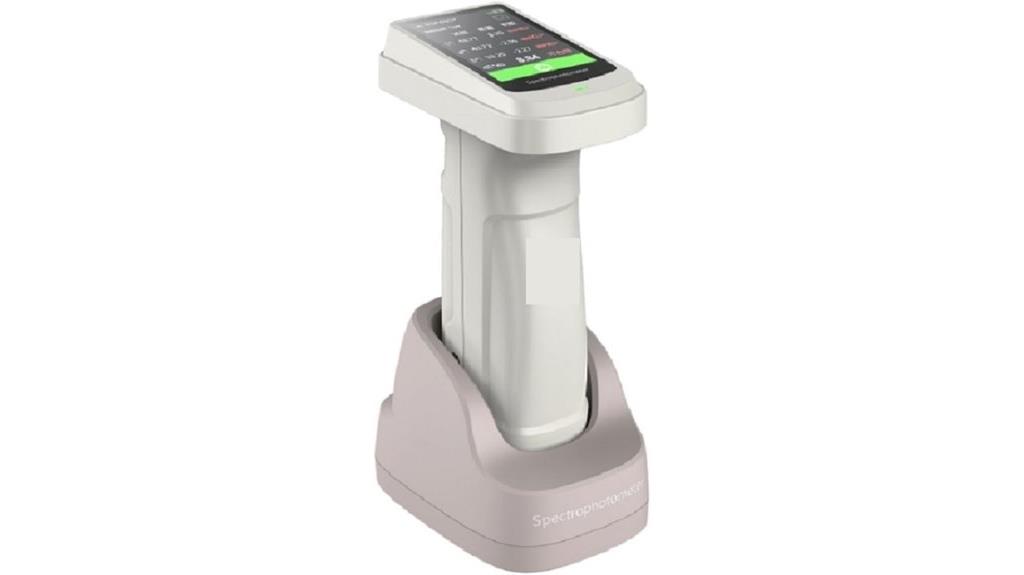
The DS-700D Spectrophotometer stands out with its broad wavelength range of 360nm to 700nm, making it ideal for professionals who need precise spectral analysis across visible and ultraviolet regions. It features dual array sensors and a grating inductor for advanced measurements, including reflectance from 0% to 200% with 0.01% resolution. Its compact, lightweight design guarantees portability for laboratory or field use, while LED and UV light sources assure accurate spectral coverage. The intuitive interface and ergonomic build make operation straightforward, even for beginners. Overall, the DS-700D combines versatility, precision, and ease of use in a reliable spectrophotometer suitable for various analytical needs.
Best For: professionals and researchers requiring precise spectral analysis across visible and ultraviolet ranges in laboratory or field environments.
Pros:
- Wide wavelength coverage of 360nm to 700nm for comprehensive analysis
- Advanced measurement capabilities including reflectance from 0% to 200% with 0.01% resolution
- Compact, lightweight, and portable design suitable for diverse settings
Cons:
- May require some technical knowledge for optimal operation despite user-friendly interface
- Limited color and size options, only available in a single variant
- As a high-precision device, it might be more expensive compared to basic spectrophotometers
Spectrophotometer, High Precision Color Spectrophotometer
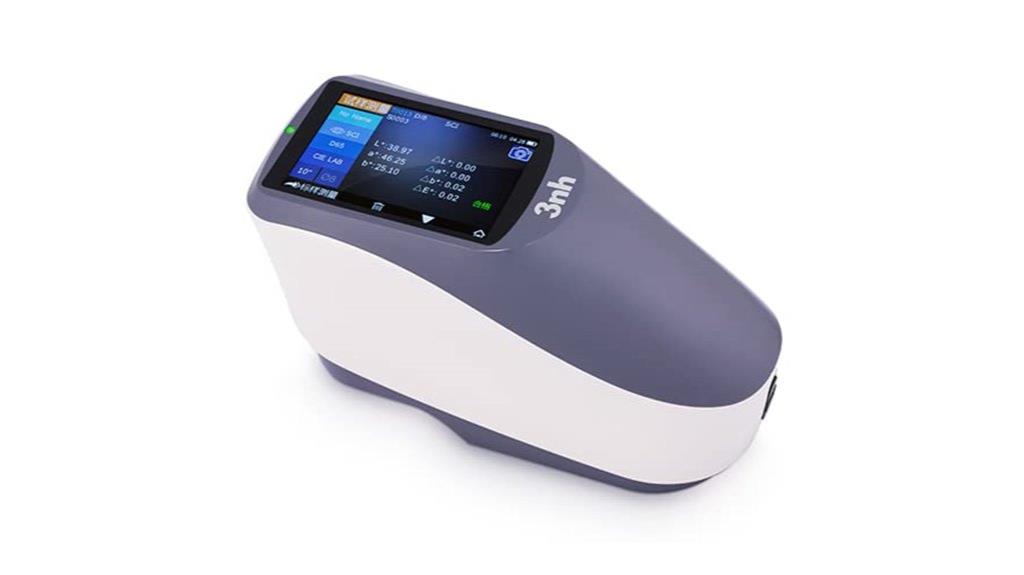
High precision color measurement stands out as a crucial feature of the Spectrophotometer model YS3060, making it an ideal choice for professionals who demand accurate and consistent color data. I’ve found it supports precise spectral data collection across standards like CIE No.15, ISO7724, and ASTM E1164. Its dual apertures and spectral range of 400-700nm enable versatile measurements, including SCI and SCE components. With fast measurement times and excellent repeatability (ΔE*≤0.03), it ensures reliable results. The device’s intuitive touchscreen, extensive data storage, and compatibility with various color spaces make it perfect for quality control, color matching, and research applications.
Best For: professionals in quality control, color matching, and research requiring highly accurate and reliable spectral color measurements.
Pros:
- Supports precise spectral data collection conforming to international standards such as CIE No.15 and ISO7724
- Fast measurement time of approximately 2.6 seconds with excellent repeatability (ΔE*≤0.03)
- Versatile with dual apertures, multiple color spaces, and extensive data storage options
Cons:
- The device’s complexity may require training for optimal use
- Higher cost compared to basic colorimeters or spectrophotometers
- Portability might be limited due to its size and weight compared to handheld units
Spectrophotometer with Touch Screen and Bluetooth
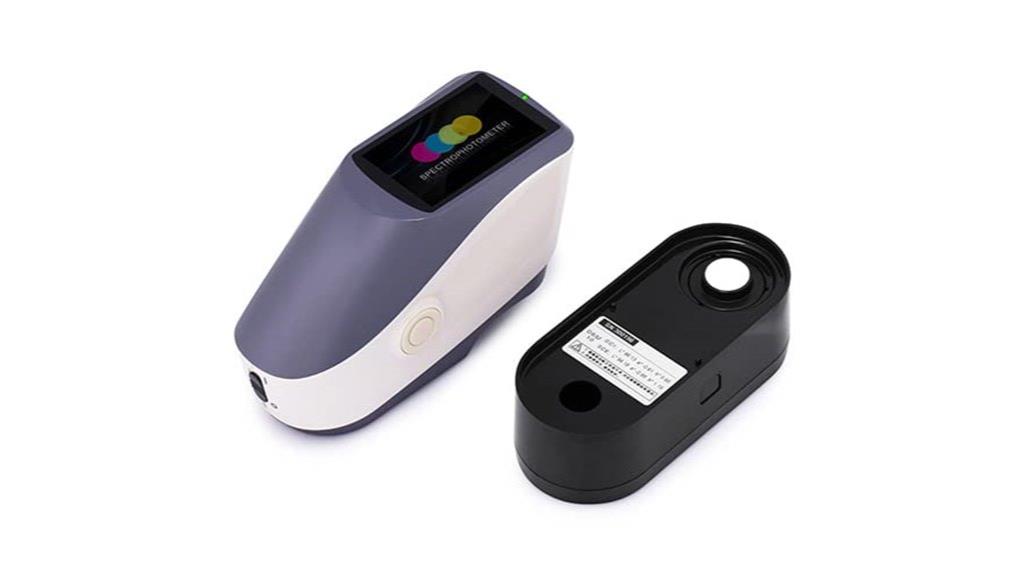
A spectrophotometer with a touch screen and Bluetooth connectivity is an excellent choice for labs seeking seamless data management and user-friendly operation. Its 3.5-inch TFT color LCD with a capacitive touch screen makes navigation intuitive, while Bluetooth 4.0 allows effortless wireless data transfer. With a wide wavelength range of 400-700nm and adjustable intervals, it offers precise reflectance measurements up to 200%. The device stores up to 2,000 data points and can hold 20,000 sample records, streamlining workflow. Its ergonomic design combines aesthetic appeal with practical human body mechanics, ensuring comfortable use during extended analysis sessions.
Best For: laboratories and research facilities seeking an intuitive, wireless-enabled spectrophotometer for precise color reflectance analysis and efficient data management.
Pros:
- User-friendly 3.5-inch TFT touch screen for easy navigation and operation
- Wireless Bluetooth 4.0 connectivity for seamless data transfer
- High storage capacity with 2,000 data points and 20,000 samples for streamlined workflow
Cons:
- Limited wavelength range (400-700nm) may not suit applications requiring broader spectrum analysis
- Handheld design might compromise stability during very precise measurements
- Dependence on electronic hardware means potential susceptibility to damage from rough handling
Portable Spectrophotometer with Auto Calibration and Data Storage
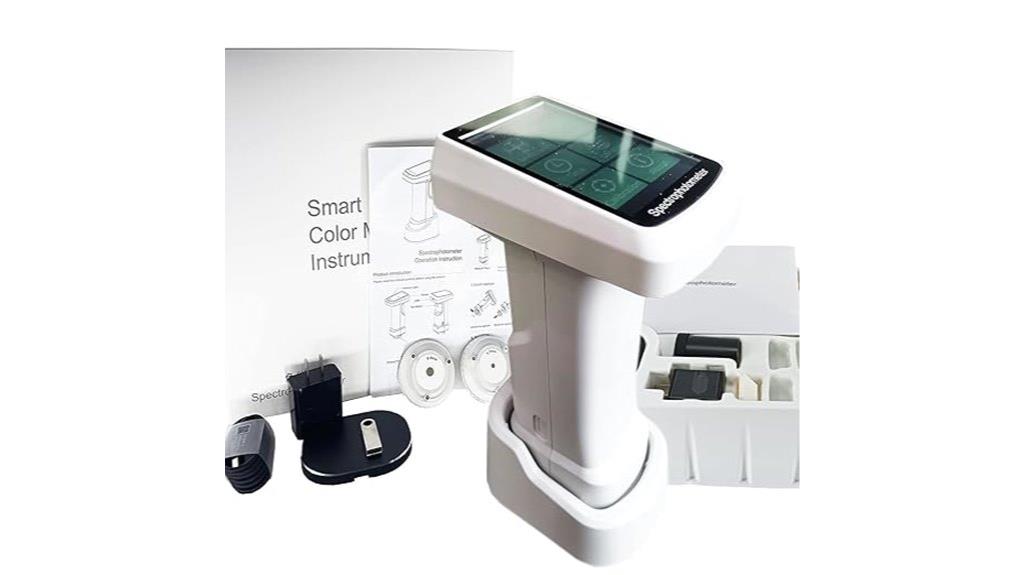
If you need a portable spectrophotometer that combines auto calibration with extensive data storage, this device stands out as an excellent choice. Its dual optical path design guarantees high repeatability accuracy, with dE*ab ≤ 0.04, while the handheld format allows easy observation of measured areas. Equipped with versatile apertures of Φ8mm and Φ11mm, it supports over 30 measurement parameters and nearly 40 evaluation light sources for exhaustive analysis. Powered by the ColorExpert color management system, it offers precise digital control and data processing. With a storage capacity of 10,000 measurements, it’s ideal for detailed color evaluation across various applications.
Best For: professionals in color quality control, printing, textiles, or any industry requiring precise, portable color measurement and extensive data management.
Pros:
- Ultra-high repeatability accuracy (dE*ab ≤ 0.04) due to dual optical path design
- Supports over 30 measurement parameters and nearly 40 evaluation light sources for comprehensive analysis
- Large data storage capacity of 10,000 measurements for extensive data management
Cons:
- May require familiarity with calibration standards like ASTM and ISO for optimal use
- The device’s advanced features could have a steeper learning curve for new users
- Portability might limit some functionalities compared to larger, benchtop spectrophotometers
Digital Spectrophotometer with 16mm TFT Colorimeter and 2.8-inch Display
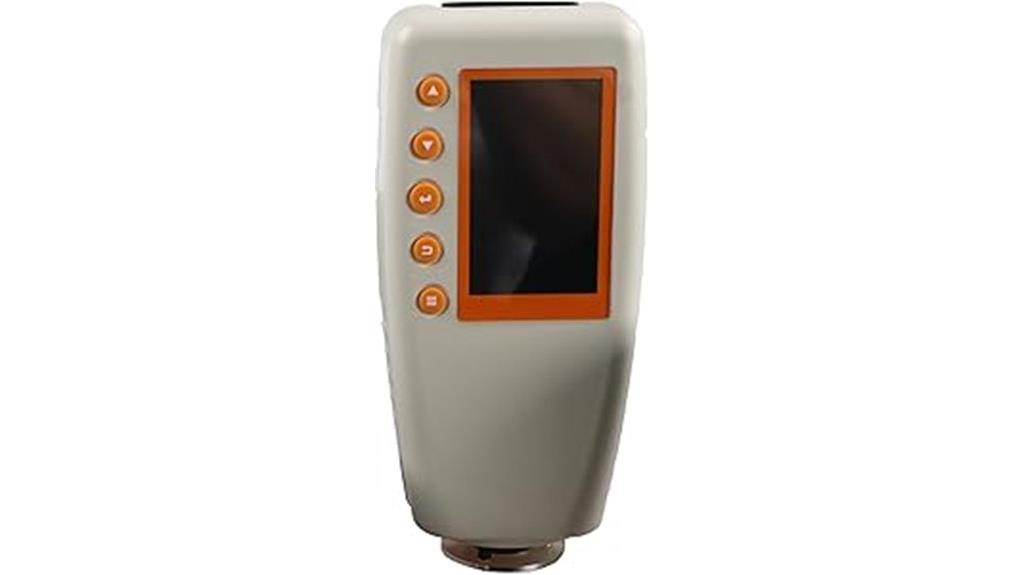
The Digital Spectrophotometer with a 16mm TFT colorimeter and a 2.8-inch display stands out as an ideal choice for professionals who need quick, accurate color measurements across various sample types. Its compact design, weighing just 1.1 pounds, makes it portable without sacrificing performance. It features a durable LED light source with over 50,000 hours of lifespan, supporting measurements of flat, powder, and liquid samples. With a wavelength range of 400-700nm and fast 2.5-second intervals, it ensures precise results. The device offers extensive data storage, multiple color space options, and reliable measurement accuracy, making it versatile for diverse applications.
Best For: professionals and researchers who require quick, accurate color measurement of flat, powder, and liquid samples in various industrial, scientific, or quality control settings.
Pros:
- Compact and lightweight design (1.1 pounds) for easy portability and handling.
- High durability with a LED light source offering over 50,000 hours of lifespan.
- Supports multiple color spaces and extensive data storage for versatile applications.
Cons:
- Limited wavelength range (400-700nm) may not cover all specialized measurement needs.
- Measurement interval of 2.5 seconds might be slow for high-speed production lines.
- Relies on a 2.8-inch display, which may be small for detailed data viewing in some cases.
Portable Spectrophotometer with USB, LCD, 320-1100nm Wavelength
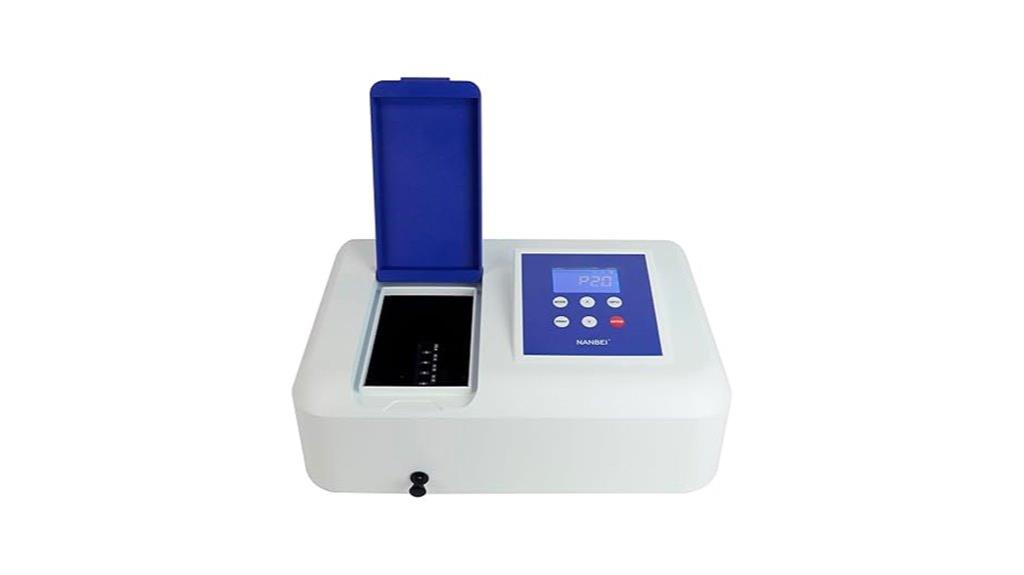
For professionals who need reliable and versatile field analysis, this portable spectrophotometer with USB, LCD, and a wavelength range of 320-1100nm stands out. It features a tungsten lamp, a backlit LCD display for easy readings, and includes four glass cuvettes. The device offers automatic wavelength adjustment within 0.5nm, zero at 0%T, and full-scale at 100%T, reducing manual errors. Its compact design makes it ideal for on-site testing in medical, food, petrochemical, environmental, and research settings. Simple to operate after a 30-minute warm-up, it delivers precise, consistent results essential for accurate analysis in the field.
Best For: professionals in medical, food, petrochemical, environmental, and research fields seeking reliable portable analysis tools for on-site testing.
Pros:
- Portable and lightweight design ideal for field and laboratory use
- Automatic wavelength adjustment reduces manual errors and enhances measurement accuracy
- Includes multiple glass cuvettes and a backlit LCD for easy, precise readings
Cons:
- Requires a 30-minute warm-up for optimal accuracy, which may delay immediate testing
- Limited to a wavelength range of 320-1100nm, not suitable for measurements outside this spectrum
- Dependence on external power supply (90-250V) may limit use in remote locations without power
23RS Spectro Spectrophotometer, 110/220V, 50/60 Hz
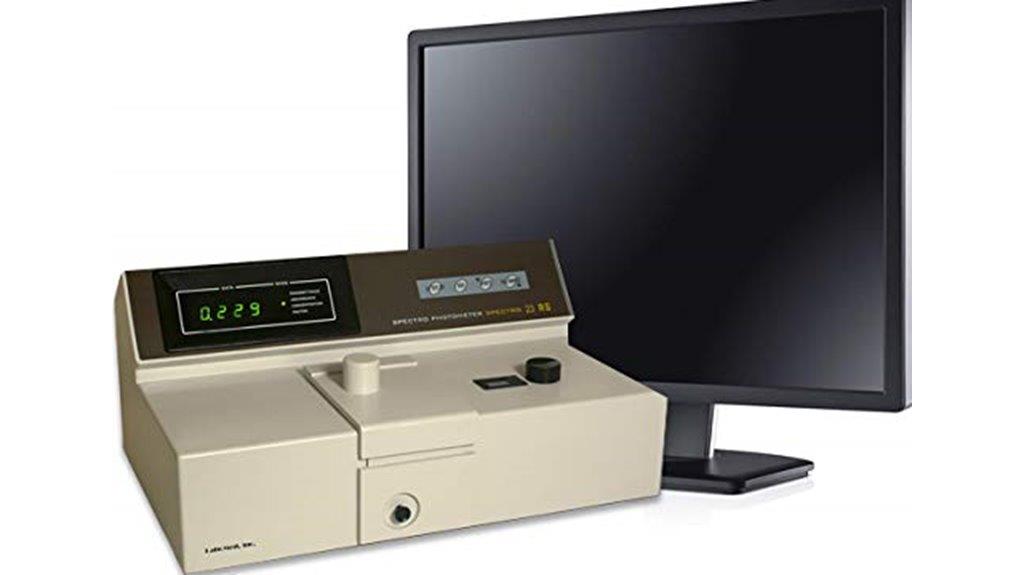
Designed for routine spectroanalytic tasks, the RS Spectro Spectrophotometer, 110/220V, 50/60 Hz, offers a compact and versatile solution suitable for laboratories, educational institutions, and field applications. It features a wide wavelength range of 320-1,100nm, with a 6nm spectral bandwidth for precise low-concentration measurements. Equipped with a tungsten-halogen lamp and silicon photodiode detector, it ensures low noise and accurate results. The device includes auto-zero, auto-calibration, and stray-light filtering functions, along with a user-friendly touch-screen interface. Its multi-cell receptacle supports testing liquids and solids, making it ideal for diverse analytical needs.
Best For: laboratory professionals, educators, and field researchers seeking precise, reliable spectroscopic analysis across various industries.
Pros:
- Wide wavelength range of 320-1,100nm suitable for diverse applications
- Low noise silicon photodiode detector ensures accurate measurements
- User-friendly touch-screen interface simplifies operation and data access
Cons:
- Relatively heavy at 35lb, which may impact portability
- Limited to a spectral bandwidth of 6nm, less precise than 1nm options
- Requires manual switching between voltage options (110V/220V) which may necessitate additional setup
Digital Spectrophotometer with 16mm TFT True Color Display
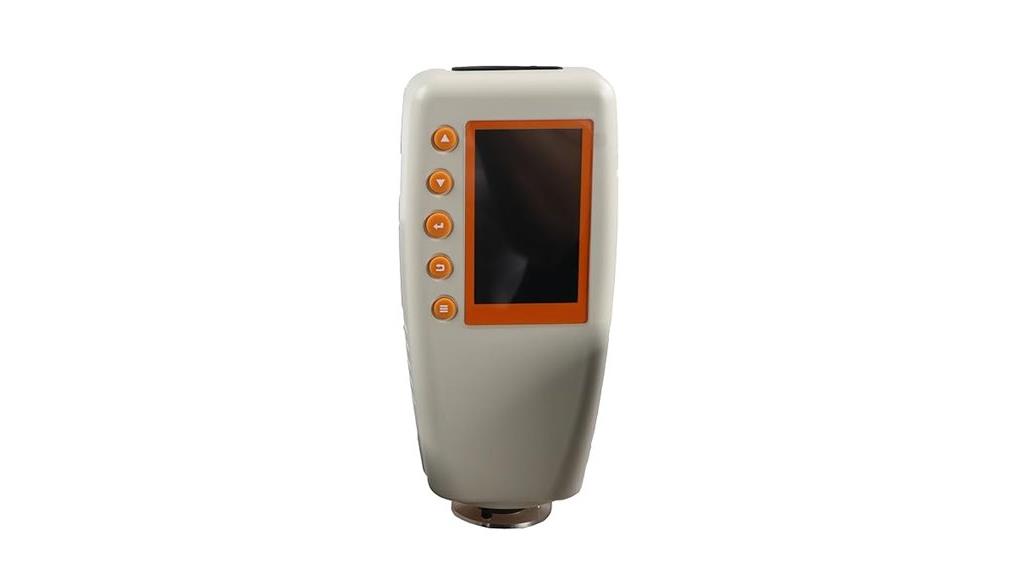
If you’re seeking a spectrophotometer that combines advanced color measurement with intuitive operation, the Digital Spectrophotometer with a 16mm TFT True Color Display is an excellent choice. It features a large 2.8-inch true color TFT screen, supporting multiple color spaces like CIEL*a*b*, Hunter LAB, and sRGB, making it versatile across industries. With a fast 2.5-second measurement time and high accuracy (deviation <0.05), it ensures reliable results. Its durable LED light sources last over 50,000 hours, and it stores up to 16,000 samples. Designed for ease of use, this device is perfect for quality control in textiles, paints, plastics, and coatings.
Best For: professionals in industries such as textiles, paints, plastics, and coatings seeking precise, rapid, and user-friendly color measurement solutions.
Pros:
- Supports multiple color spaces including CIEL*a*b*, Hunter LAB, and sRGB for versatile applications
- Fast measurement time of only 2.5 seconds with high accuracy (deviation <0.05)
- Durable LED light sources with a lifespan exceeding 50,000 hours and extensive data storage (16,000 samples)
Cons:
- May be more expensive compared to simpler or less feature-rich spectrophotometers
- The 16mm aperture may limit measurement size for larger or uneven samples
- Requires familiarity with different color spaces and formulas for optimal use, which could have a learning curve
Factors to Consider When Choosing Atomic Absorption Spectrophotometers
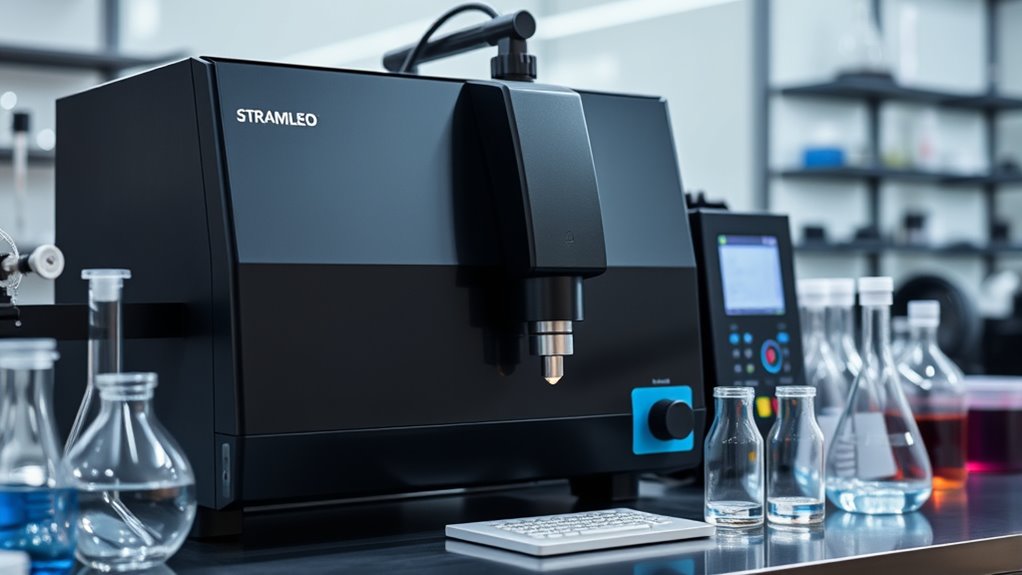
When choosing an atomic absorption spectrophotometer, I consider several key factors to guarantee it meets my needs. These include measurement range flexibility, detection sensitivity, ease of use, safety features, and portability. Understanding these points helps me select the best instrument for accurate, efficient analysis.
Measurement Range Flexibility
Choosing an atomic absorption spectrophotometer with flexible measurement ranges is essential for accurate analysis across diverse sample types. A broader measurement range enables me to detect multiple elements with varying concentrations, reducing the need for multiple instruments. Instruments with adjustable wavelength settings help optimize sensitivity and selectivity for different metals within the same device. Flexibility in dynamic range, like high and low concentration detection, ensures I can analyze both trace and major metal levels accurately. Some models offer dual or multi-range modes, allowing simultaneous measurement in a single run, which saves time and increases efficiency. Additionally, the ability to calibrate across different ranges enhances overall accuracy and minimizes the risk of saturation or under-detection, making the instrument adaptable to varying analytical demands.
Detection Sensitivity Level
Detection sensitivity level directly impacts my ability to identify trace amounts of metals accurately. It determines the lowest concentration an instrument can reliably measure, which is vital for detecting contaminants at very low levels. Instruments with higher sensitivity have lower detection limits, allowing me to identify metals at parts-per-billion or even parts-per-trillion levels. Factors such as light source intensity, monochromator resolution, and detector efficiency influence this sensitivity by affecting the signal-to-noise ratio. Advanced spectrophotometers incorporate sophisticated signal processing and noise reduction to improve accuracy, especially for low-concentration samples. Choosing a model with appropriate detection sensitivity ensures reliable results in applications like environmental testing, food safety, and clinical analysis, where detecting trace metals is often a key requirement.
Ease of Operation
Selecting an atomic absorption spectrophotometer with ease of operation is essential for efficient and accurate analysis. A device with a simplified control panel and intuitive interface minimizes training time and reduces user errors. Automatic functions like ignition, calibration, and baseline correction streamline workflows, allowing for quicker setup and more consistent results. Clear display screens and step-by-step prompts guide operators through each measurement, even with limited technical experience. Pre-programmed analytical methods and automatic parameter adjustments further simplify operation and ensure reproducibility. Additionally, user-friendly safety features such as automatic gas source cut-off and protective mechanisms make the instrument safer to use, especially for less experienced users. Overall, ease of operation enhances productivity and confidence in your analytical results.
Safety Features Included
Safety features are a critical consideration when evaluating atomic absorption spectrophotometers, as they help prevent accidents and protect both users and the instrument. Many models include automatic gas source cut-off systems that prevent leaks and potential explosions during operation. Low-pressure protection mechanisms safeguard the instrument’s internal components and guarantee user safety if pressure irregularities occur. Power-off protection systems automatically shut down the device during electrical faults or abnormal conditions, preventing damage and hazards. Automatic ignition functions facilitate safe, consistent startup procedures, reducing the risk of accidents. Additionally, safety interlocks and alarms alert users to issues such as gas leaks or electrical faults, promoting safe handling throughout testing. These features are essential for maintaining a secure laboratory environment while guaranteeing reliable instrument performance.
Portability and Size
When choosing an atomic absorption spectrophotometer, considering its portability and size is essential, especially if you plan to use it in the field or limited-space environments. Portable models are designed with compact dimensions and lightweight materials, making them easy to transport and operate on-site. Size impacts how easily you can handle the instrument and how much space it will occupy, which is critical in tight laboratory settings. Many smaller units integrate components to save bench space, ideal for labs with limited room. Features like battery power and wireless connectivity further enhance flexibility, allowing deployment outside traditional labs. However, I also consider that highly portable models might have some limitations in sample throughput or analytical capabilities, so balancing size with performance is key.
Maintenance and Support
Maintaining an atomic absorption spectrophotometer requires dependable support from the manufacturer, as this guarantees you can troubleshoot issues promptly and keep the instrument running accurately. I look for exhaustive technical support, including troubleshooting, calibration, and maintenance guidance, to ensure longevity and consistent performance. Authentic replacement parts and consumables are essential, reducing downtime and maintaining accuracy over time. User-friendly features like automatic cleaning and self-diagnostics simplify routine maintenance, saving time and effort. Regular software updates and calibration services are also vital to keep the instrument aligned with current standards. Finally, I evaluate warranty terms and after-sales support, as prompt assistance minimizes operational disruptions and ensures the instrument remains reliable for precise analysis.
Frequently Asked Questions
What Maintenance Routines Ensure Optimal AAS Spectrophotometer Performance?
To keep my AAS spectrophotometer performing at its best, I regularly clean the burner and nebulizer to prevent buildup. I also check lamp alignment and replace lamps before they burn out. Calibration is essential, so I perform it frequently using standard solutions. Additionally, I inspect gas lines for leaks and make certain the instrument is properly warmed up before use. These routines help maintain accuracy and longevity.
How Do Different Light Sources Impact Measurement Accuracy?
Did you know that the light source in an AAS can affect measurement accuracy by up to 15%? Different sources, like hollow cathode lamps or D2 lamps, emit specific wavelengths that influence sensitivity and precision. I’ve found that selecting the right light source based on the element being analyzed guarantees reliable results. Regularly calibrating and maintaining these sources keeps your measurements consistent and accurate over time.
Can Portable AAS Devices Replace Lab-Based Systems?
Portable AAS devices can be a great option for field testing and quick analyses, but they typically can’t fully replace lab-based systems. I find that lab instruments offer higher precision, better sensitivity, and more advanced features for complex samples. While portable units are convenient and improve on-site decision-making, for the most accurate and reliable results, especially with challenging samples, I still rely on traditional lab-based AAS equipment.
What Software Features Enhance Data Analysis and Reporting?
When it comes to software features that boost data analysis and reporting, I look for intuitive interfaces, automated calculations, and customizable report templates. Real-time data visualization helps me identify trends instantly, while built-in calibration tools guarantee accuracy. Export options in multiple formats make sharing results easy. Overall, powerful software streamlines my workflow, reduces errors, and makes presenting findings clear and professional.
How Do Environmental Factors Affect Atomic Absorption Measurements?
Did you know that environmental factors can cause up to 15% variation in atomic absorption measurements? I’ve seen how temperature fluctuations, humidity, and air currents can disrupt the flame or graphite furnace stability, leading to inaccurate results. I always guarantee a controlled environment for testing, because even minor changes can skew data. Proper lab setup and calibration are essential to minimize these effects and keep analysis precise and reliable.
Conclusion
Choosing the right atomic absorption spectrophotometer is like finding a needle in a haystack, but with the right guidance, you’ll uncover a tool that transforms complex analysis into a walk in the park. Each of these models offers unique strengths, ensuring you’ll find one that fits your needs perfectly. Remember, the best instrument is the one that brings clarity to your work, turning data into insights with the precision of a finely tuned instrument.
